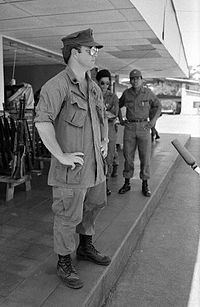Name Albert Schaufelberger | ||
 | ||
Similar People Alfonso Navarro, Ignacio Ellacuria, Farabundo Marti, Segundo Montes, Oscar Romero | ||
Albert Arthur Schaufelberger (August 8, 1949 - May 25, 1983) was a Lieutenant Commander in the United States Navy who was assassinated in El Salvador.
Contents
Background
Schaufelberger was a graduate of the United States Naval Academy at Annapolis, Maryland and was an avid (150 lb) American football and lacrosse player while in college. His father, Albert Arthur Schaufelberger (Senior), was a decorated fighter and bomber pilot during the Vietnam War.
Role in El Salvador
Lieutenant Commander Schaufelberger was the senior U.S. Naval representative at the U.S. Military Group, El Salvador. He was a United States Navy SEAL, second in command of the U.S. Military Group advising the Salvadoran Military on counter insurgency and weapons traffic interdiction operations. In addition, he was security chief for the 53 U.S. military advisors in the country at the time. Schaufelberger had responsibility, among other duties, for naval operations in the Gulf of Fonseca which were run out of the La Union naval base. It was at the La Union naval base where Schaufelberger allowed himself to be photographed for the last time several days before his assassination. Schaufelberger's death was the first of a U.S. military member in El Salvador following the October 1980 arrival in country of U.S. military advisors.
Assassination
At approximately 6:30 pm on May 25, 1983, Schaufelberger was assassinated on the grounds of the Central American University in San Salvador. A group under the umbrella of the Farabundo Marti National Liberation Front (FMLN), the Central American Revolutionary Workers' Party (PRTC), is thought to have carried out the act.
Schaufelberger had been dating the manager of a cooperative store, Consuelo Escalante Aguilera, for several months and developed a routine of picking her up at the same time and place. On May 25 he arrived and sounded the horn of his armored embassy-provided Ford Maverick, his signal to inform his date that he had arrived. Ms. Aguilera exited her office and observed what she believed to be a white Volkswagen microbus pull up and stop near Schaufelberger's car. Reportedly several individuals were involved with the assassination, with at least one firing through the open window of Schaufelberger's car. Schaufelberger's was shot four times in the head. Schaufelberger's car leaped forward, impacting a car directly in front of it. The assassins then jumped into their vehicle and escaped. Unfortunately for him, Schaufelberger had removed the bullet-resistant glass over the driver's-side window after the air conditioner in his vehicle had broken.
Schaufelberger saw his role in El Salvador of preventing a communist takeover of the country for all of the people of El Salvador—not just those of means. He realized, however, that he might be a target of the insurgents, given the success of the weapon interdiction efforts. During his last discussion with journalists covering U.S.-advised Salvadoran military operations, Schaufelberger told those present that the insurgents "know who I am, and where I live". His house had apparently already received drive-by gunfire on a recent evening prior to the assassination.
Press coverage
Albert Schaufelberger's assassination was featured on the front cover of the June 6, 1983 edition of Newsweek magazine. The U.S. edition was headlined The First Casualty and the international edition Shooting to Kill.
Schaufelberger was photographed in uniform and interviewed by international media representatives (including Newsweek) one week before his death. Previous pictures of Schaufelberger had been taken by the Magnum Photo Agency in Paris for a syndicated feature story on the escalating U.S. military involvement in the region. For security reasons Schaufelberger appeared in those photos as a rear view only and in civilian clothes.
